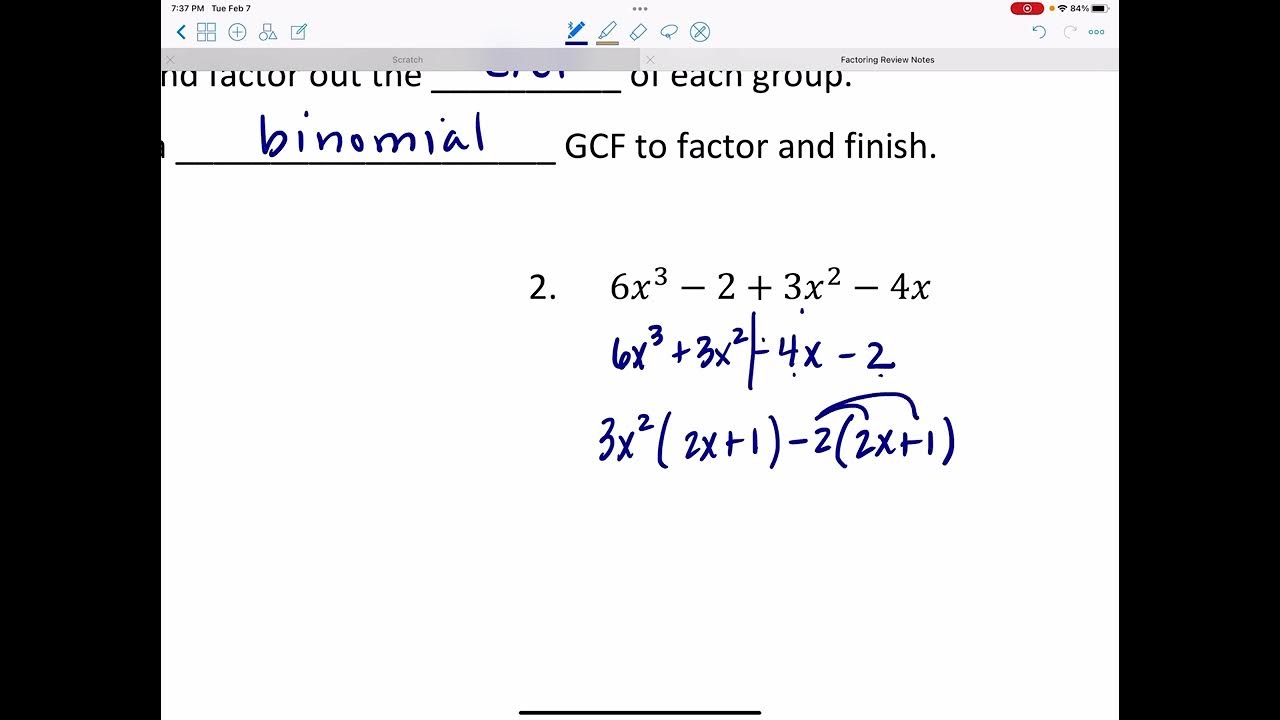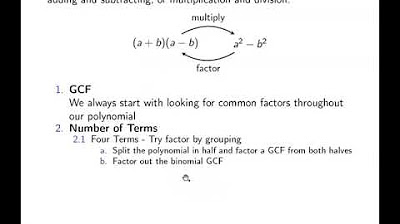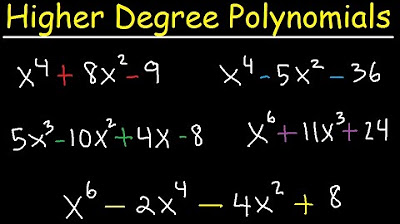How To Factor Polynomials The Easy Way!
TLDRThis instructional video offers a comprehensive guide on factoring polynomials with various examples. It begins with extracting the greatest common factor (GCF) from simple polynomial expressions and progresses to factoring trinomials with a leading coefficient of one, then moves on to more complex scenarios, including expressions with higher degree terms and non-GCF scenarios. The video also covers factoring by grouping and handling perfect square differences. It concludes with strategies for factoring polynomials with four terms and similar ratios, providing a clear and structured approach to mastering polynomial factoring.
Takeaways
- 📚 Start by identifying the greatest common factor (GCF) in polynomial expressions to simplify them.
- 🔍 For expressions like 3x^3 - 9x^2 and 4x^2 - 12x, factor out the GCF and simplify the terms to get x(x^2 - 3x) and 4x(x - 3) respectively.
- 📈 Factoring trinomials with a leading coefficient of one involves finding two numbers that multiply to the constant term and add to the middle coefficient.
- 🔑 Example: x^2 + 2x - 15 factors to (x + 5)(x - 3) by using the numbers 5 and -3.
- 🌐 When the leading coefficient is not one, like in 2x^2 - 6x - 56, first factor out the GCF and then proceed to factor the resulting trinomial.
- 📉 For expressions like 3x^2 - 18x + 24, factor out the GCF and then find two numbers that multiply to the constant term and add to the middle coefficient to complete the factorization.
- 💡 Factoring expressions like x^2 - 16 or x^2 - 64 involves recognizing and applying the difference of perfect squares formula.
- 📌 The square root of the squared term becomes the base of the binomial factors, and the square root of the constant term determines the signs of the binomial factors.
- 🔄 For expressions that don't have an obvious GCF, like 2x^2 - 5x - 3, multiply the leading coefficient by the constant term to find two numbers that add to the middle coefficient and multiply to the product.
- 📝 Factor by grouping, which involves taking out common factors from groups of terms and then factoring out the common binomial from the resulting expression.
- 🧩 Practice factoring by working through examples like 6x^2 + x - 15, which requires a combination of the methods discussed in the video.
Q & A
What is the first step in factoring the polynomial 6x - 12?
-The first step is to take out the greatest common factor (GCF), which is 6, resulting in 6(x - 2).
How is the polynomial 3x^3 - 9x^2 factored?
-The GCF of 3x^2 is taken out, resulting in x^2(3x - 9), and then further simplified to x^2(3)(x - 3).
What is the process for factoring the expression 4x^2 - 12x?
-First, take out the GCF which is 4x, resulting in x(4x - 12), and then simplify to x(2)(x - 3).
When factoring trinomials with a leading coefficient of one, what should you look for?
-You should look for two numbers that multiply to the constant term and add up to the linear coefficient.
How do you factor the trinomial x^2 + 2x - 15?
-You find two numbers that multiply to -15 and add up to 2, which are 5 and -3, resulting in (x + 5)(x - 3).
What is the first step in factoring the polynomial 2x^2 - 6x - 56?
-The first step is to factor out the GCF, which is 2, resulting in 2(x^2 - 3x - 28).
How is the expression 3x^2 - 18x + 24 factored?
-First, factor out the GCF which is 3, resulting in 3(x^2 - 6x + 8), and then factor the trinomial inside to get 3(x - 4)(x - 2).
What is a difference of perfect squares and how is it factored?
-A difference of perfect squares is an expression of the form a^2 - b^2, and it is factored as (a + b)(a - b).
How do you approach factoring the polynomial 2x^2 - 5x - 3?
-Multiply the leading coefficient by the constant term to get -6, then find two numbers that multiply to -6 and add to -5, which are -6 and 1, and use factoring by grouping.
What is the process for factoring the polynomial 3x^3 - 2x^2 - 12x + 8?
-First, notice the ratio between the coefficients and factor by grouping, taking out x^2 and -4 from the respective terms, resulting in (x^2 - 4)(3x - 2), and then factor the difference of squares to get (x + 2)(x - 2)(3x - 2).
Outlines
📚 Introduction to Factoring Polynomials
This paragraph introduces the concept of factoring polynomials with simple examples. It explains how to factor expressions like 6x - 12 by taking out the greatest common factor (GCF), which is 6, resulting in x - 2. The process is repeated for 3x^3 - 9x^2 and 4x^2 - 12x, where the GCFs are x^2 and 4x, respectively. The paragraph then transitions to discussing the factoring of trinomials with a leading coefficient of one, using the example of x^2 + 7x + 12, which factors into (x + 3)(x + 4). The method involves finding two numbers that multiply to the constant term and add up to the linear coefficient.
🔍 Factoring Trinomials and Special Cases
This paragraph delves deeper into factoring trinomials, particularly when the leading coefficient is not one. It provides a step-by-step example of how to factor x^2 + 2x - 15 by identifying two numbers that multiply to -15 and add up to 2, which are 5 and -3, leading to the factored form (x + 5)(x - 3). The paragraph also covers the factoring of expressions with a leading coefficient other than one, such as 2x^2 - 6x - 56, by first factoring out the GCF of 2 and then applying the same trinomial factoring technique. It also touches on the factoring of perfect square trinomials like x^2 - 64 and the difference of squares, demonstrating the process with examples.
📘 Advanced Factoring Techniques
The final paragraph discusses advanced factoring techniques, including factoring by grouping and handling polynomials with more than three terms. It provides an example of factoring a four-term polynomial, 3x^3 - 2x^2 - 12x + 8, by recognizing a common ratio in the coefficients and factoring by grouping. The paragraph also explains how to deal with trinomials that do not have a common factor and cannot be factored by simple methods, such as 2x^2 - 5x - 3, by using the 'ac method' and factoring by grouping. The video concludes with a summary of the factoring techniques covered and an invitation to explore more examples through the provided links.
Mindmap
Keywords
💡Factoring Polynomials
💡Greatest Common Factor (GCF)
💡Trinomial
💡Difference of Perfect Squares
💡Factoring by Grouping
💡Leading Coefficient
💡Polynomial Expression
💡Perfect Square
💡Binomial
💡Coefficient
Highlights
Introduction to factoring polynomials with simple examples.
Factoring 6x - 12 by taking out the greatest common factor (GCF).
Factoring 3x^3 - 9x^2 by identifying the GCF of 3x^2.
Factoring 4x^2 - 12x by taking out the GCF of 4x.
Explanation of factoring trinomials with a leading coefficient of one.
Factoring x^2 + 2x - 15 by finding numbers that multiply to -15 and add to 2.
Factoring 2x^2 - 6x - 56 after factoring out the GCF of 2.
Factoring 3x^2 - 18x + 24 by taking out the GCF of 3.
Factoring expressions like x^2 - 16 and x^2 - 64 as differences of perfect squares.
Factoring 2x^2 - 5x - 3 using the method of factoring by grouping.
Approach to factor 6x^2 + x - 15 by multiplying the leading coefficient by the constant term.
Factoring 3x^3 - 2x^2 - 12x + 8 using the ratio of coefficients for factoring by grouping.
Final example of factoring a four-term polynomial with a similar ratio in coefficients.
Factoring a difference of perfect squares situation in the final example.
Conclusion and thanks for watching with a prompt to check out more examples in the description.
Transcripts
Browse More Related Video

Factoring Trinomials & Polynomials, Basic Introduction - Algebra

Factoring Polynomials - By GCF, AC Method, Grouping, Substitution, Sum & Difference of Cubes

Factoring Review

Factor Polynomials - Understand In 10 min

Ch. 1.3 Algebraic Expressions

Factoring Higher Degree Polynomial Functions & Equations - Algebra 2
5.0 / 5 (0 votes)
Thanks for rating: